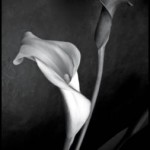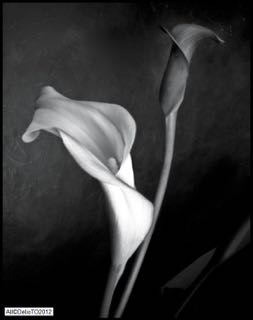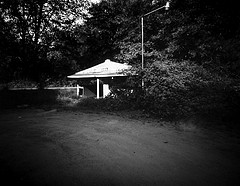At ƒ/D our mission is not only to inspire, but to inform in a way that we hope leads to further discovery. Today I want to dive into some of the details of how a pinhole camera “works” so that we can all better wield this tool we’ve chosen. This is a somewhat technical subject, but I’m going to do my best to stay above water. I’m going to do the math for you – but there’s a link at the end of this for those that revel in complicated math and details.
Circles of Confusion
In photography, “Circles of Confusion” (CoC) are what make up the image that you see in the final photo. Blurry portions of photos taken with a lensed camera are made by large CoC, and sharp portions of a photo are made by small CoC. So what are CoC? In a word: points. Fine detail is produced by the optics of the camera resolving the many rays of light that make up that detail into many tiny tiny points. Blur (not including motion blur) is produced by out of focus areas that are resolved into much larger spots. If you get your face super close to your screen, you’ll see everything is made of thousands of little dots, called pixels – this is very similar to a photo’s CoC.
A pinhole camera works by creating CoC’s that are all the size of the pinhole. Light travels in a straight line, and in a scene there’s gazillions of straight lines reflecting off of your subject. Those straight lines travel through the pinhole, at the size of the pinhole, and then hit your film. Contrast this with a camera that uses a lens – that lens works by bending the light and focusing it to a much smaller CoC, and thus a much greater amount of detail onto the film plane.
The Pinhole Look
First, let’s take a second to define what the “pinhole look” is. I believe it can be characterized by 2 things:
- infinite softness and
- infinite Depth of Field
There are those that would argue that qualities such as vignetting, distortion, and long exposure are also part of the pinhole look, but each of those qualities can either be designed out of a pinhole camera or mitigated with light and film speed.
Infinite Softness
Now that we know what a CoC is (again, Circle of confusion), let’s take a second to understand how that translates into the aesthetics of a pinhole photo. Your typical pinhole is going to range from 0.2mm to 0.5mm. Because of the physics involved, your CoC is going to be roughly the same size – not exactly the same size, but close enough for this article. So a pinhole camera that has a 0.2mm pinhole will have CoC that are about 0.2mm as well. By comparison, a typical DSLR with lens is producing CoC that are about 0.019mm. That’s 10 times smaller! That’s also 10 times sharper.
Since the CoC produced by a pinhole camera must be many times larger than those produced by a DSLR or just about any other well designed lensed camera, we get softness at all points of the photo as a result of the pinhole photograph.
“Infinite” Depth of Field and the Real Limitations
Now we know that the resolving sharpness (CoC) of a pinhole camera is much less than that of a DSLR. But what does that really mean? Well, the first impact is in Depth of Field. Recall that Depth of Field is the distance over which parts of your subject will appear to be in focus. It’s often said that pinhole cameras have an infinite Depth of Field, but that’s a little misleading.
It’s misleading to say that pinhole cameras have an infinite Depth of Field because while that is technically true, the practical Depth of Field is limited by the CoC. Why? Consider a landscape photo, with some trees that are 500 yards away. Let’s say you’re shooting this scene with 2 cameras: one a medium format pinhole camera with a 0.3mm pinhole and the other and the other a medium format lensed camera set on f/22 for maximum Depth of Field. Imagine those trees, when projected onto the film, are 1mm tall. In your pinhole camera, those trees are going to be represented by about 3 CoC (1/0.3 = 3.3). In your lensed medium format camera, which produces CoC of 0.053mm, there will be about 20 CoC. Remember, more circles equals more sharpness! So while the pinhole camera has infinite Depth of Field, it runs into a limitation of resolving power because of the CoC.
At this point, you might get the bright idea to just use a smaller pinhole. Hold your horses! If you go smaller than the prescribed pinhole for your camera, physics is going to put a stop to you right there. But the reason why is whole ‘nother article. Suffice to say, for now, go with the size pinhole that’s prescribed for the dimensions of your camera.
The Impact of Circles of Confusion
So what does all this mean? What the hell is the point? What are you getting in exchange for this headache? Armed with this information, we can make better choices for our artistic vision.
Digital Workflows
If you’re like many pinhole photographers today, you are shooting with film or paper negatives, and then scanning them into your computer where you apply some digital touching up before publishing. CoC make it all the more important in this workflow to really nail your exposures. Having less detail in the negative means there’s less detail to work with later. Dodges and burns that would have worked on a DSLR photo will look fake on a pinhole photo, because there’s less detail to manipulate. This means that you’ll want to ditch that habit of telling yourself you’ll photoshop it later, and instead take up the mantra: “Get it in camera!”. Perhaps a refresher in ole Ansel Adams’s classic, “The Negative “.
“.
Film Formats
Your choice of film format can have a great impact on your level of sharpness. This is true in all photography, but especially true in pinhole. Consider our previous example – the medium format pinhole camera with the 0.3mm pinhole. All things being equal – the scene, the exposure, an appropriate pinhole size, and the angle of view of the camera – a 4×5 camera will produce 2.5x more detail than the medium format camera! Now of course we’re not in pinhole photography for the sharpness. But there are times when sharpness needs to be considered. If your subject, or the scene, includes lots of details and, further, you want to highlight some of those details, you may want to consider using a 4×5 or even 8×10 camera. At other times, when the scene or your vision is free of fine details, you can safely use your medium format or 35mm pinhole camera.
Composing a Shot
What do you envision from the final print from the photo you’re taking? If the magic in this shot is depending on some distant or small piece being recognizable, consider the amount of resolution your film will have based on your pinhole size. No way does this mean get out the ruler and old trigonometry textbooks – but rather take a moment to visualize how large that detail will be on the film plane and if you’re going to have the desired detail needed. Granted – much of this relies on practice, but we’re here to flatten the learning curve, not remove it!
Wrap Up
Hopefully this helps you be a better pinholer now and for many years to come. Again, in short:
- The softness in the details of pinhole photography means you have less detail to work with during burning and dodging, so get the exposure right!
- If you need more detail, use a larger format
- Visualize the final print and make sure that you’re framing for the detail that you feel is needed to make the photo work!
As promised, if you need further info, including the detailed math behind CoC, there’s a very good write-up on Wikipedia.
Did I bring clarity or stir up the mud? Let me know in the comments below, or hit me on twitter @fslashd
 April 17: We highlighted Delio Ansovini’s wonderful pinhole still life photography.
April 17: We highlighted Delio Ansovini’s wonderful pinhole still life photography. April 24: We had a talk with Scott Speck about how he came to pinhole photography and what drives his creative vision.
April 24: We had a talk with Scott Speck about how he came to pinhole photography and what drives his creative vision.
